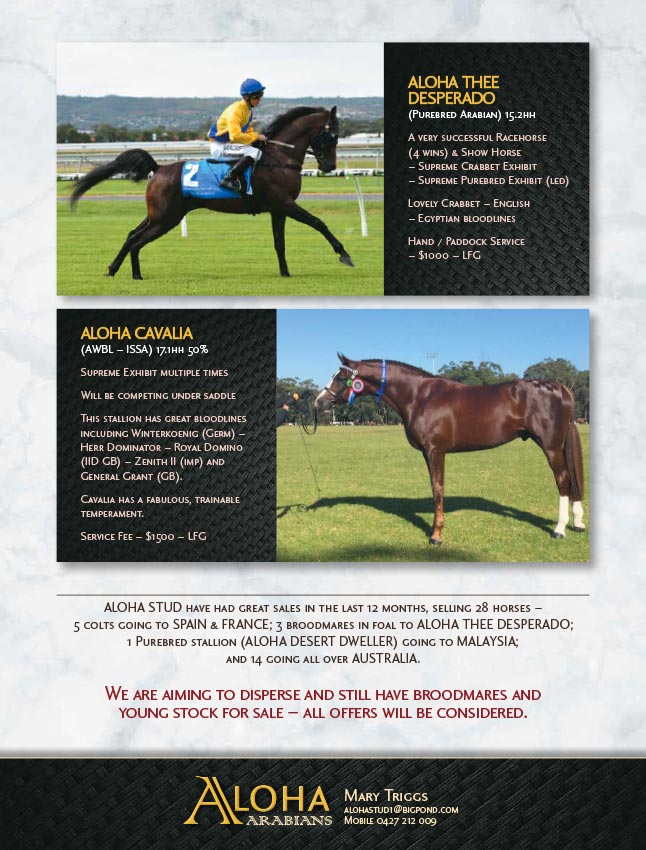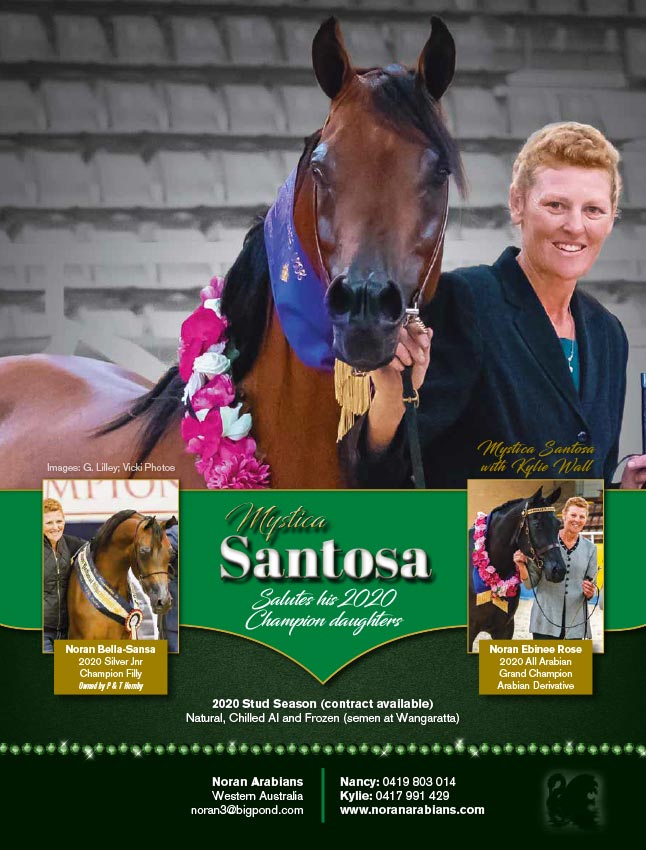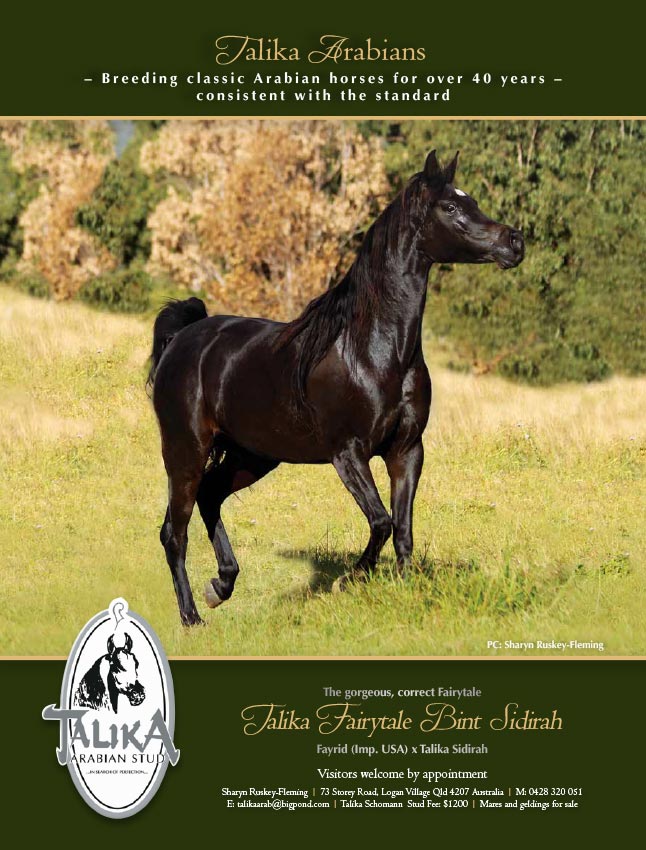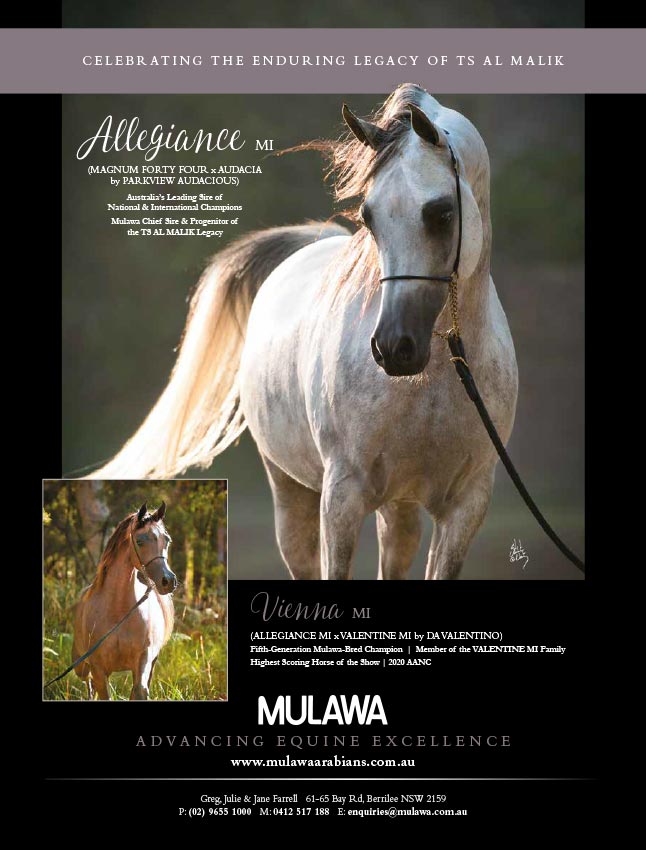
A Tale of Two Arabians
July 11, 2017
RHR Heir of Marwan Arrives in Europe
July 11, 2017Is Stallion Ownership for you?

Simeon Shifran (Asfour x Simeon Shavit) pictured at Simeon Stud Good fencing is an absolute requirement for stallion management. Photo: Stuart Vesty
Ultimately the main reason people keep stallions is to use them in their breeding program.
The model for a perfect stud farm is a good group of broodmares, a safe and functional facility and a great stallion to stand at stud. Right? Not necessarily. In this modern age of horse breeding, does it really make sense to have your own stallion? Let’s take a look at the pros and cons of stallion ownership and decide.
Not everyone should have a stallion. This goes beyond the assumption that many breeding farms keep their own stallion. Not everyone should own a stallion for a variety of reasons.
Housing Stallions
Let’s start with housing. Unless your stallion runs out with the mares, which is not common any more, he will have to be kept in a separate, stallion-safe enclosure. So whether it is a stall or a paddock or both, it needs to be high enough and sturdy enough that the stallion cannot push his way out. And believe me, if there are mares in heat, he will be testing his physical boundaries constantly. Ideally, a stallion fence should be high enough that he cannot rest his chest against the rail and have his neck and head over the fence. This just encourages him to push against the fence, or in a worst case scenario, try to climb or jump out. If the fence is high enough so that he can only get his head over the top, he will realise that it is not feasible to try to jump.
If your fence is not high, a reliable electric wire or tape will keep the stallion off the fence. However, notice the word ‘reliable’. If the wire is not hot all the time, the stallion will test it and if he finds it off, will make the best of the opportunity. The fencing material should be sound and sturdy. Board fencing, vinyl, pipe fencing or mesh are all good materials for fencing. If in a stall, it should be solid and not have any gaps or holes that he can get caught in. Pay particular attention to the top of the stall walls and any rafters. Can the stallion get hung up in a rafter if he stands on his hind legs? You may think this is excessive or overkill, but just a few months ago, we had a stallion that was at a boarding facility stand on his hind legs and get his neck wedged into the ‘vee’ of the roof rafter and the top of the stall. He hung himself before anyone could get him down.
Can the stallion see other horses from his paddock? His stall? Can he see mares? Hear them? Smell them? Horses are herd animals. Isolation is very stressful for horses, yet we isolate stallions where they can’t see or be around other horses. That is not fair. Ideally the stallion should be able to see other horses from his enclosure. A ‘buddy’ gelding stalled or put in the paddock next to him is much better for the stallion’s mental health. Plus, it mimics being in a mini ‘bachelor’ herd situation. Stallions that are shut away and isolated from all other horses also can develop behaviour problems.
Why all of this care for having a stallion? Because a stallion is hard-wired to do one thing. Breed mares. No matter how friendly, how sweet, whether you have raised him from a foal or just bought him. That is his number one priority. Everything else is second. This is how Mother Nature made them – so that they would reproduce. We need to respect that. In nature, stallions would be running with mares or in bachelor groups. However, in our modern world, we have to keep them in a stall or a paddock. This causes a number of concerns. One is energy. A stallion normally expends a great deal of energy (in nature) driving off other stallions, protecting the herd and breeding mares. Lock him in a stall or small paddock and what happens to all that energy? It can manifest in behaviour disorders, or a stallion that bites or savages himself or in destructing his surroundings. Therefore, if you do keep a stallion, exercise is paramount. Ride, drive or work the horse in some way so that he has a way to expend excess energy. Many of the large Thoroughbred farms ride their stallions daily – not only to keep them fit and burn energy, but to subliminally assert the human’s dominance every day as well. Which brings us to the topic of handling stallions.
Handling Stallions
Not everyone should have a stallion, because most people should not handle stallions. Most people should not handle stallions because when they do, they treat the stallion unfairly. Stallions are often expected to act like a machine – act like a breeding stallion today with a mare, but by golly don’t you dare act like a breeding stallion at the show tomorrow!!! Is it any wonder stallions get confused? If you are going to have a stallion, you have a responsibility to make it very clear to the stallion when breeding behaviour is acceptable and when it is not. But be consistent and be fair. Doing the breeding in the same arena where the stallion is worked is not fair. How is he to know when he goes to the arena if he is supposed to be ‘on’ or ‘off’. Using different tack for breeding is important, but if you are going to have a breeding stallion, you need to have a separate area for the breeding to take place.
If you are doing artificial insemination (A.I.), you will need to have a breeding shed, ideally a phantom mare (dummy) and a small laboratory for processing semen. That requires an outlay for facilities, equipment and training. Additional personnel will likely be required as well. Who will handle the stallion for breeding (ideally not the trainer who handles for shows)? Who will do the collecting of semen? Processing of semen? If you choose to stand a stallion and do A.I. and don’t want to have your own breeding laboratory, then you will have to take your stallion to a specialist facility each time you need him to be collected. You will have to weigh the risks of transportation, disease exposure and expense to decide which method is best suited to your operation.
Other common handler errors are being overly harsh and aggressive with a stallion. Yes, they need to be respectful – always – and obedient. But people that are afraid of stallions tend to punish them for any perceived or real indiscretion. As in ‘don’t you dare move an inch, until I tell you, you SOB!!!’ The handler is nervous and wants to control every action of the stallion. This is unfair, and ultimately impossible. The more you try to micro-manage every move a stallion makes, the likelihood increases that he will just blow up in frustration. And it won’t be pretty.
The flip side to that type of handling is the ‘my stallion loves me and would never hurt me’ handler. This type of handler believes they have a special bond with their stallion and that they (the handler) can do things with their stallion that no one else can. They allow the stallion to be the boss in the situation and ultimately the stallion ends up disrespectful and pushy towards humans and can become dangerous. Let me tell you a little secret. Your stallion may tolerate you, your stallion may like you – but your stallion does not love you – especially if there is a mare in estrus within a ten mile radius. This doesn’t mean you can’t have a good relationship with a stallion. I have had many! But it is based on mutual respect and is more of a partnership. But 60-50 in favour of the human! People who are anxious, nervous or scared of stallions should not handle them. People who want to dominate them and show them ‘who’s boss’ should not handle them.
Using Stallions in your Breeding Program
Ultimately the main reason people keep stallions is to use them in their breeding program. The stallion has traits that the breeder wants to incorporate into the program and using their own stallion is easier and cheaper than using outside stallions. Maybe yes, maybe no.
If you use your own stallion, you need to breed a rather large number of foals from different mares to find out your stallion’s strengths and weaknesses. Producing just a few foals will not give you the complete picture. ‘No problem’, is the answer. ‘I will just breed him to a group of outside mares and have my answer.’ Furthermore, as the thought process plays out, visions of multiple stud fees rolling in just sweetens the deal. Reality check. Breeding outside mares involves having facilities for the mares if they are going to stay at your farm. You will be on very good terms with your vet who will be coming out every day to check the mare when in estrus. You will need to have a contract that spells out all the costs – vet, board, collections, breedings, etc. What happens if the mare does not get in foal? What happens if she aborts? Do you provide a ‘live-foal’ guarantee? Should the mare be cultured? If she is being live covered, what precautions are you taking to ensure both the stallion’s and mare’s safety?
So, without having a fairly large number of foals on the ground and grown to the age of two to three years, you don’t really know how your stallion produces.
Not having a Stallion
If you don’t have a stallion, you immediately have a much happier barn. No squealing, kicking, urinating and bouncing off the walls – and the horses behave much better as well! You don’t have to have custom or stallion-proof facilities.
Genetically, you can have your pick of stallions from around the world, if you are willing to use frozen semen or chilled semen. You can research many different stallions and any offspring online (though I recommend looking at the stallion in person and offspring in person or video at very least) and determine whether the stallion is passing on traits that you require. With your own stallion this will take at least five years. By utilising outside stallions, you can make more genetic progress in a much shorter period of time.
You are not limited to your own stallion, or local stallions. Not that there is anything wrong with local or owned stallions. Again, the genetic diversity may be more limited in a geographic region as vast as Australia. Bringing in outside genetics may help diversify a breeding program. Or limit it.
For very popular stallions, having access to them worldwide via frozen or shipped semen can actually limit a gene pool. If everyone breeds to the same stallion for multiple generations, then we have a gene pool that is flooded with the same bloodlines. That is actually the case right now in the Arabian industry in North and South America for sure. Because of the distances involved and the regulations and cost associated with using imported semen in Australia, there are not as many stallions used repeatedly as is seen in the US, South America and to some extent, Europe. However, it works both ways. Not being able to access a wide range of stallions to diversify breeding programs limits bloodlines to what has historically been bred in Australia. It does, however, keep the overuse of a few very popular stallions from abroad from flooding the pedigrees of horses in Australia as well.
There are good arguments both for and against the need to own your own stallion. If you can provide him with a happy and healthy life, both physically and mentally, and you have the skill set to handle a stallion, then you are a good candidate. If not, you might want to reconsider and look at the wide range of stallions available for breeding – and see where they might fit into your program without having to own one!!!!
































